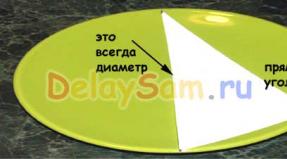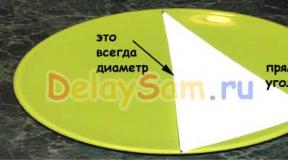Coursework. Passport of the technology room (educational workshop) Plan diagram of the educational school workshop with equipment
Training workshops are equipped with basic equipment for individual and general use. The main equipment for individual use includes: in a turning workshop - lathes, in a metalworking workshop - workbenches with vices. The main training and production equipment for general use includes machines for sharpening tools, marking plates, etc.
The average amount of shared equipment is set at 10% of all personal equipment. The arrangement of equipment in a training workshop can be frontal and linear. Layouts of student workplaces are selected depending on the shape of the training workshop premises.
For training purposes, the most convenient is a linear arrangement of equipment, when workbenches or machines are located in three or four rows facing the foreman’s workplace.
Training workshops must be interconnected by technological process. Turning - next to the milling. Workshops where work involves a lot of noise, dust and gas emissions must be isolated. The area norm per student is as follows: for turners 8-11 m2, milling operators 9-12 m2, fitters 4.3 m2. The width of passages between machines or workbenches must be at least 0.8 m, and passages between rows of machines or workbenches must be at least 1.2 m. The width of passages is 2 m. Training workshops must comply with safety regulations, the equipment must be in good working order, have fencing, protective devices, grounding, safe means of work.
Student's workplace
A student’s workplace should be understood as a certain part of the workshop area under the control of one student, with equipment, tools, fixtures, and materials located on it. The equipment must provide high productivity and make it possible to carry out the educational process in accordance with the requirements of software, technical aesthetics and NOTES. At the workplace there is only what is needed for the current work. Tools and parts are arranged in such an order that they can be used conveniently. What is taken with the right hand is placed on the right, what is taken with the left hand is placed on the left. Every thing must have its place. This arrangement of tools, workpieces, and materials ensures a minimum of tiring movements during work.
Software foreman's workplace
The workplace is located so that the master can see all the students’ workplaces and observe their work. In turn, students should see and hear everything that the master tells and shows from his workplace. The workplace rises 250-300 mm above the floor. The requirements for the workplace are: convenience, speed and quality of functions for teaching students; exemplary equipment, aesthetic design of training and production work, equipment, technical documentation, TCO. Everything should be in its place, “at hand”, and not require much time to search. The area of the podium is 12 m2. On the podium there will be a methodological cabinet, a table, a demonstration workbench, and a machine. The methodological cabinet houses TCO, tools, documentation, drawings, and maps. The master must keep his workplace in exemplary condition so that it can be an example.
6. Certification of workplaces of students, software masters, scientific workshops
Certification is carried out in order to determine the provision of comprehensive technological and methodological equipment for the software process in educational workshops and is carried out in accordance with the “Regulations on Certification...” approved on October 27, 1986. During certification, attention is paid to: technical and pedagogical level of workplaces masters, students; correspondence of the number of student jobs to their contingent; availability of all equipment, fixtures, tools, devices necessary for the production of products provided for by the curriculum; equipped with technological documentation in accordance with the requirements of GOST, ESKD, ESTPP for manufactured products.
Chapter 4.
JOB TRAINING TOOLS
The formation of students' skills and abilities occurs primarily in the process of their educational and production work associated with the use of raw materials, equipment, tools, fixtures, instruments and other objects and tools. All this amounts to logistics industrial training.
Another component of industrial training means is educational and methodological equipment. These are teaching aids that provide the pedagogical side of the educational process: textbooks, educational and visual aids, technical teaching aids, educational and methodological documentation and manuals, reference, normative, didactic materials, etc.
4.1. Logistics support for industrial training
As noted in Chap. 1, a specific feature of the process of industrial training is the combination of training students in specially created conditions (training workshops, training grounds, educational farms and laboratories, on simulators, training installations, etc.) and in production conditions.
Training workshops
A training workshop is a special premises of a vocational educational institution, equipped with the necessary equipment, tools, instruments and other equipment, intended for industrial training; structural unit of a vocational educational institution.
In educational workshops, students' professional skills and abilities are formed in the process of performing, as a rule, educational and production work using machines, mechanisms, devices, installations, tools, and devices typical for the profession (group of professions) being mastered. Here students acquire skills in the rational organization of work and the workplace, are accustomed to work culture, rational use of working time, compliance with safety requirements and standards, sanitary, hygienic and environmental requirements, production and technological discipline.
The role and place of training in a training workshop in the general educational process are determined by the specific content of work in various professions (groups of professions). Where, in specially created conditions, it is possible to rationally combine the solution of educational and production problems (training of turners, milling operators, welders, tailors, etc.), students are trained in training workshops, as a rule, up to 60% of the time allocated for industrial training. When training workers and specialists in professions related to the maintenance, repair, and adjustment of complex production equipment, for which it is inappropriate to create special training workshops, students in general training workshops master, as a rule, only general professional labor skills: general metalworking, electrical installation, construction, finishing, etc., for which 15-20% of the time is allocated 1.
The premises for training workshops, their layout and equipment, and the features of organizing educational and production activities in training workshops are different for different professions. Specific design options are also different. They largely depend on the material, technical and financial capabilities of educational institutions, the experience and skill of the teaching staff, the general style of their activities and many other factors. At the same time, despite the great variability of organizational and design solutions, it is possible to identify general requirements that must be observed and taken into account when creating and improving training workshops as a whole and their components.
The complex of educational workshops of an educational institution is usually built into the end of the educational building with sound-absorbing walls and a covered gallery-transition at the level of the 1st-2nd floors. The training workshop complex is also being constructed as an autonomous building. This placement has a number of advantages: the inevitable production noise does not distract students in classrooms and laboratories; dust, soot, gases do not violate sanitary and hygienic conditions in the educational building; additional space allows you to organize auxiliary services and household premises.
The total area of the training workshop is determined taking into account the need to provide each student with an independent workplace for practicing professional skills, to locate common-use equipment, as well as additional equipment for carrying out production activities.
Premises for training workshops must meet conditions for the normal installation and operation of equipment. Workshops where heavy equipment is installed, where work involves significant vibration, machine tools, forging, welding, machine assembly, repair, etc. are located on the ground floor; metalworking, electrical installation, radio installation, sewing, etc. workshops are on the second and third floors.
Of great importance for creating a comfortable industrial training environment are lighting in the training workshop, wall painting, temperature conditions, ventilation, and noise absorption. Training workshops must also comply with occupational safety and fire safety requirements.
The basis of the complex of educational workshops of an educational institution are specialized workshops for industrial training in a certain profession (a certain type of work). As a rule, training workshops are created for a full training group, i.e. for 25-30 jobs. Each workshop usually has its own area isolated from other workshops.
In addition to specialized training workshops, the complex includes production and support premises and services. In relation to training workshops that produce complex products, they include: production site; instrumental and distribution pantry; technical control department; repair shop, warehouse, etc. Specialized training workshops and production and support services are located according to the principle of direct flow of technological processes for manufacturing multi-part typical products (orders). The building of training workshops will also provide sanitary facilities and facilities.
Specialized training workshops are equipped with personal equipment, on which students practice professional skills. At one time, when some educational institutions had rich “basic workers” - basic enterprises, there was an unspoken competition between them to equip training workshops with the latest modern equipment. Moreover, in a number of cases, the leadership of vocational education authorities and their inspectorates assessed educational institutions not so much by educational indicators, but by the level of provision of industrial training with modern equipment. This fact in itself is generally positive, but in modern conditions it is necessary to take into account both the capabilities and feasibility of such equipment. Firstly, with the liquidation of the “institute of basic enterprises”, educational institutions lost the opportunity to replenish and improve their educational and production equipment for free, while purchasing the latest equipment themselves is very expensive. Secondly, any equipment, especially modern, high-performance equipment, must pay for itself, and given the current difficulties with receiving orders and selling products, this is very difficult. Therefore, it seems more appropriate to equip training workshops with a small amount of modern equipment designed to implement new technologies, and organize training on it according to the schedule of senior students. The rest of the training and production equipment should be considered as a teaching tool that allows students to acquire skills and abilities that correspond to the level of qualifications provided for by the standard of vocational education.
In addition to equipment for individual use, training workshops are equipped with equipment for general use. The range and quantity of such equipment depend on the specifics of the training workshops’ products, the future professions of the trainees, the availability of support services at the educational institution and a number of other factors. The main purpose of public equipment is to ensure high-quality implementation of industrial training programs.
The design of educational workshops is of great importance for solving educational and educational problems. It depends on the capabilities of the educational institution, the initiative and experience of the master, and the general design style of the educational institution. When decorating the interior of a training workshop, it is necessary to proceed from expediency and observe a sense of proportion.
____________________________
1 Due to the changing nature of the relationship between educational institutions and enterprises (formerly basic ones) in the context of the country’s transition to a market economy and the organization of their own production in educational institutions, such relationships can vary widely: manual for training a profession (collection of instruction cards); album of working drawings; album of technological maps, etc.
We all once studied at school and had great pleasure in working in workshops and labor training classrooms: boys removed shavings from wooden blanks, girls sewed aprons and baked pancakes. Time does not stand still, and now labor lessons are called “technology”.
In the technology classrooms, students, as before, sew, cook, saw and plan. Just as the older generation once did, teachers, special equipment, and demonstration visual aids help them acquire the practical skills they need for life. This is where the similarities end.
The modern school curriculum has been developed taking into account the new requirements of the federal state standard, and includes three areas of technological education for schoolchildren, namely: technical, service and agricultural work. The effectiveness of teaching the subject directly depends on whether the workshops are equipped with the necessary equipment.
The equipment of the labor office in the Federal State Educational Standards school is regulated by the “Recommendations MD-1552/03 dated November 24, 2011” of the Ministry of Education and Science of the Russian Federation and the “List of educational and computer equipment for equipping general education institutions (letter of the Ministry of Education and Science of the Russian Federation No. 03 -417 dated April 1, 2005).” The school equipment proposed in these documents is typical and sufficient for acquiring practical skills and fully mastering educational material in the subject “technology”.
Each school can adopt the recommended list of technical, educational, practical, laboratory and other teaching aids as a basis. However, this list is not exhaustive, and educational institutions can expand it by attracting additional funding. Let us note that the active filling of school workshops in the course of equipping the labor room at the school according to the Federal State Educational Standard with modern tools for processing materials involves the partial replacement of outdated mechanical devices with electrical ones.
Some educational equipment is potentially hazardous. Therefore, along with special furniture, machines, devices and tools, schools are required to purchase stands and tables with general safety rules for technology lessons. Technology classrooms for girls are provided with visual materials on how to safely work with a sewing machine, iron and kitchen appliances; workshops for boys are equipped with demonstration materials on wood and metal processing.
All purchased equipment must meet the following criteria:
· relevance;
· safety;
· compactness;
· compliance with the physical and psychological development of the student;
· ease of operation and maintenance.
Table of equipment for the labor room at school in accordance with the requirements of the Federal State Educational Standard
|
General educational, practical and visual equipment |
Cabinet equipment for girls |
Workshop equipment for boys |
|
Work robe or apron Safety glasses A set of technological tables on lesson topics. |
1. Sewing: Work table Sewing machine Three-thread overlock Weaving machine Mannequin for several sizes Measuring tools for working with fabrics Hand sewing tools Templates for cutting garments · for knitting; · for crocheting; · for embroidery. Tools for moistening and heat treatment of fabrics 2. Cooking: Kitchen equipment set: · desktop; · electric stove; · dish dryer; · fridge; · microwave oven. Kitchen equipment for thermal processing of food products Kitchenware set: · enamel bowls; · tableware; · set of cutlery. · table service; · tea service. Cutting equipment: · vegetables. Items for table setting |
1. Carpentry: Carpentry workbench Carpentry tools Measuring tools Marking devices Wood carving tools Wood drill bits Burning device Jigsaw kit Wood hacksaw Wooden deck 2. Plumbing: Metalworking workbench Locksmith tools Measuring tools Marking devices Thread cutting tool Metal drills Files Muffle furnace Anvil Hacksaw for metal Metal cutting scissors Electrical equipment and power tools for: · drilling holes; · sharpening tools; · milling of workpieces; · surface grinding; · dissolution of workpieces; · jointing. 3. Housekeeping technology: Set of tools for plumbing work Sanitary products Tools and additional equipment for repair and finishing work Household appliances and care equipment: · behind the house; · for clothes; · for shoes. |
In addition to the sections listed, special attention is paid to training schoolchildren in agricultural work. The range of equipment purchased for schools is wide; it depends both on the financial capabilities of the educational institution and on the specifics of local agricultural sectors.
Theoretical lessons in technology lessons are carried out using the tools, devices and equipment listed in the Recommendations. As for practice, purchasing tractors and other agricultural equipment for a school is not always justified.
The equipment of the labor office in a school according to the Federal State Educational Standard is not limited to the material and technical base alone. In addition to machines and tools, technology lessons require the use of computer and multimedia equipment, and electronic learning tools. All workplaces of schoolchildren and teachers are automated. Technical conditions are being created for the use of information and communication teaching aids.
Locksmith workshop (department). In the metalworking workshop, students process metals by hand and on machines; Here they also perform electrical work. In accordance with this, the metalworking department is equipped with metalworking benches, metal-cutting machines and some auxiliary equipment.
Today, the issue of creating equipment that is height adjustable is very relevant. After all, students in grades V-X, who differ significantly in their height, have to work in the same workplace. Meanwhile, it is known, for example, that a worker can maintain the correct posture during metalworking if the vice is located at such a height that, placing his elbow on it, he can touch his chin with the straightened fingers of his raised hand.
In this regard, a number of proposals have been made that make it possible to change the height of the workplace or the position of the worker relative to the workplace.
When working on machines, this is achieved through stands that are placed under the feet. As for metal workbenches, a number of designs have been developed that allow them to be changed in height. Let's give an example of one of them.
The workbench consists of a frame made of welded pipes and a square. The workbench cover is a metal frame in which 30 mm thick hardwood boards are fixed. The top of the lid is covered with sheet metal 1...2 mm thick. Under the lid of the workbench there are two drawers designed for storing tools and accessories. A stop is attached to the bottom of the lid. Clamps secure the guide pipes of the cover in the pipes of the frame legs. The lid is lifted with a screw. On the right side of the lid there is a preparation area for marking and measuring tools. A music rest is attached to the left side of the lid, on which instructional and operational cards are placed. The preparation table and music stand can be adjusted in height. If necessary (when chopping metals), a protective mesh can be attached to the workbench. The workbench is designed for students to perform plumbing and electrical work. To straighten and mark the workpiece, a steel plate is attached to the lid with screws.
Before performing electrical work, the vice is removed from the workbench and placed in the left drawer. The workbench can also be used as a table when taking notes from the teacher’s explanations and performing graphic work (to do this, the vice is shifted to the left from the middle of the workbench cover). In addition to single-seat workbenches, in school practice there are two- and four-seat workbenches.
The list of standard educational equipment for school workshops includes the following metal-cutting machines: lathe type TV-7 - 3 pcs.; drilling type 2M112 - 1 pc.; horizontal milling type NGF-100 - 1 pc.; electric sharpener - 2 pcs.
Of course, it is not always possible to purchase exactly the specified models of machines, so you should be guided by the fact that the most convenient for working with students are lathes with a center height of 150...160 mm and a distance between centers of 600...800 mm; It is advisable to have drilling machines with a maximum drilling diameter of 12 mm.
Auxiliary equipment is also installed in the metalworking department: 1-2 marking plates, a plate for straightening workpieces, a muffle furnace, a test bench for electrical work. In addition, the metalworking department will be additionally equipped to perform heat treatment of steel.
Equipment in workshops is placed taking into account certain rules and regulations. The task in this case comes down to ensuring good teacher supervision of students’ work, sufficient illumination of workplaces, and compliance with sanitary and hygienic standards.
Thus, it is recommended to install metal-cutting machines closer to the teacher’s workplace, so that in case of danger he can always be nearby. Marking boards should be placed closer to the window so that their illumination is sufficient, since the work performed on them requires significant visual strain.
All workplaces are positioned so that the light falls on them from the front or left. Between rows of metalworking benches, as well as between metal-cutting machines, it is necessary to maintain a distance of about 900 mm.
While studying in workshops, students use various tools and equipment, which can be divided into two groups: individual and general use.
Each workplace is provided with tools and equipment for individual use. At the workplace to perform plumbing work there must be a caliper with an accuracy of 0.1 mm, length 150 mm; plumber's ruler 500 mm long; fitter's square; scriber; center punch; locksmith's compass; chisel with a blade width of 10 mm; chisel with a blade width of 20 mm; hacksaw; hand metal scissors; mechanic's hammer weighing 250 g; mechanic's screwdriver; wire cutters; mallet for working on tin; flat file; flat personal file.
The workplace for performing machine tools is equipped with the following: a set of cutting tools - through cutters, scoring cutters, cutting off cutters, boring cutters, cylindrical cutters, disk cutters, cutting cutters; a set of measuring instruments - scale ruler, caliper, micrometer; a set of accessories for a lathe - a three-jaw chuck and a driving chuck, a key to the chuck, centers, clamps, adapter bushings, a drill chuck, pads for the cutter. It is advisable to have tools and equipment for general use in 2-3 copies. There may be different ways to store tools.
Particular attention should be paid to the equipment of the teacher’s workplace, which should serve as a model for students. The teacher's workbench and table are placed on a platform measuring approximately 2500x1500x300 mm. A chalkboard is mounted on the wall, and a drawing tool is placed under it. The cabinet is designed for storing tables and educational technical documentation. In some schools, teachers make the workbench rotatable so that students can look at how to perform work techniques from different angles.
At the teacher’s workplace it is necessary to have a demonstration table with single- and three-phase current supplied to it and a device for voltage regulation. It is advisable to supply power to student workstations and the demonstration table through an electrical panel, which is best placed in a niche behind the demonstration table. This panel should have a common switch that can be used to relieve voltage at all student workplaces.
Standard designs for school educational workshops do not provide for separate rooms for electrical installation work. For this purpose, the plumbing department is most often retrofitted and equipped in a special way. To do this, wooden panels are strengthened on the walls for electrical work, and plug sockets are placed near them. It is necessary to have 10-15 such shields; Sometimes they are placed on workbenches to carry out work. Stands and tables with equipment necessary for studying electrical machines are also installed. Students can test assembled electrical circuits connected to a current source only under the guidance of a teacher on a test bench specially equipped for this purpose.
To perform electrical work at each workplace, it is necessary to have special kits, including pliers, round nose pliers, side cutters, 5-10 screwdrivers, and repair knives.
The set of electrical fittings and materials required for each practical work is best stored in separate boxes measuring 200x120x600 mm. Such a kit should be prepared for each workplace. On the box you can write the number of the workplace and the name of the practical work. To check electrical circuits, you must have an ohmmeter (conveniently type M-57) or an avometer (one of these devices should be included in the equipment of the teacher’s workplace), a test lamp and a voltage indicator. When selecting tools for electrical work, you must keep the following in mind; screwdrivers, as a rule, should have plastic insulating handles, and the handles of pliers, pliers, round nose pliers, wire cutters, and knives should have covers made of insulating materials. Hammers, drills, bolts and tension cords are used less often in work, so they can be considered tools for general use and have 2-3 copies, giving them to students if necessary. Experience shows that hammers weighing 200 g and hand drills with a set of drills with a diameter of 2, 3, 5, 7 mm are convenient for students.
To increase the effectiveness of teaching techniques for performing electrical installation work, it is necessary to use visual aids. They can be printed or hand-made tables, boards and stands with samples of electrical materials and fittings, images of circuits, electrical fittings and electrical appliances. Here is an approximate list of stand equipment: samples of wires and cords; samples of insulating materials; posters reflecting the technology of connecting, branching, terminating wires, charging plugs, sockets, sockets and switches; samples of fuses and posters depicting their charging; electric bell and electromagnet.
For demonstrations in classes devoted to electrical engineering, the teacher uses some instruments from the physics or electrical engineering classroom: a set of three-phase current, working models and cross-sections of direct and alternating current machines, a magnetic starter, thermal relays, ammeters and voltmeters.
In technical labor lessons in grades V-X, various devices are widely used, intended primarily to improve the quality of products, raise the level of work culture, and form a correct understanding of the basics of modern production.
The experience of schools shows that labor education teachers pay great attention to equipping the educational process with various devices for bending, cutting, riveting, stamping metals, sharpening tools, etc. The magazines “Technical Education” and “School and Production” systematically place the best devices on their pages .
The use of devices from the point of view of educational tasks becomes especially effective if students are involved in their design and manufacture.
In accordance with the list of standard educational visual aids, the locksmith workshop must be provided with educational tables (“Safety precautions”, “Typical parts, components and connections”, “Tables on technical work for classes V-X”, “Electrical work”, “Technical design”, “Metal-cutting machines”, “Electrical engineering in labor lessons”) and filmstrips (“What a schoolchild needs to know about metals and alloys”, “Safety precautions when processing metals in school workshops”, “Motion transmission and conversion mechanisms”, “Processing metal cutting”, “What a schoolchild needs to know about the use of electricity in everyday life”, “Installation of electrical wiring”.
Carpentry workshop (department). When equipping a carpentry workshop, basically the same issues are resolved as when equipping a locksmith workshop. Here it is also necessary to provide the ability to adjust the height of the workbenches. The height of the workbench should be such that the palm of a student standing straight is pressed against the surface of the lid. As you can see, the height of the workbench is directly dependent on the student’s height.
In the carpentry workshop, wood lathes with a center height of 150...200 mm and a distance between centers of 500 mm (3 pcs.), a combined tabletop machine (joint and circular saw) with a disk with a diameter of 200 mm and a knife length of 1500 mm, and also a mechanically driven sharpener.
The list of standard educational visual aids includes the following tools and equipment for individual use: a metalworker’s ruler 500 mm long; carpenter's square; carpentry thicknesser; simple single planes with mechanical knife feed, blade width 40 and 45 mm; sherhebel with mechanical knife feed; semi-jointer with mechanical knife feed, knife width 40 mm; fine-toothed hacksaw for mixed sawing, blade length 200...250 mm; hacksaw for longitudinal sawing, blade length 300 mm; flat chisel 10 mm and 20 mm; chisel 6 mm and 10 mm; semicircular rasp 250...300 mm long; flat file 250...300 mm; jigsaw with adjustable saw tension; carpenter's hammer weighing 250 g; mallet; pliers 150 mm; screwdrivers 5 and 10 mm; awl.
The same list defines tools and equipment for general use: electric glue gun 127/220 V with a capacity of 1...2 l; drills 5...20 mm (set); carpentry chisels 4, 8, 12, 16 mm (set); erunok; zenzubel; brace; fry; folding meter; bow saw; circular saw; universal wiring for saws; plane with double knife; feather drills 12...30 mm; flat chisels 4, 6, 8, 12, 15 mm; folding tapestry; cycle; tzinubel.
In a carpentry workshop, you must have auxiliary equipment - glue brushes, different paint brushes, a glass cutter.
In the wood processing process, fixtures can be widely used. In practice, devices for marking, planing, sawing, marking tenons, etc. have proven themselves positively. Many of them are universal, that is, after readjustment they can be used for processing parts of various sizes and configurations. The carpentry workshop is equipped with filmstrips: “What a schoolchild needs to know about wood”, “Safety precautions when processing wood in school workshops”, “Technology for making products in school workshops”.
One of the prerequisites for the proper organization of the educational process in school workshops is planning the need for materials, equipment, and tools. Only by knowing in advance exactly what objects will have to be manufactured can you distribute them by class and by time. A labor teacher should not allow cases when orders for the production of certain products arrive unexpectedly and there is no time left to coordinate the content of students’ work activities with the curriculum. To prevent this from happening, the labor teacher draws up a work plan in advance for repairing equipment and equipping workshops with devices, collects applications from the head of classrooms and the head of the school’s economic department, orders from enterprises, and then, together with the director or head teacher of the school, draws up a work plan for school workshops.
Based on the work plan of the workshops, calendar-thematic plans for work with students of individual classes are drawn up, i.e., for each class, objects of work are selected that correspond to the curriculum.
All work that is carried out in workshops must be taken into account. It is also necessary to take into account all material assets. For this purpose, two books are started. In one they keep records of equipment, tools, fixtures, materials, etc., in the other - finished products. Books are needed for financial verification. In this regard, they indicate when materials and tools were received, in what quantity and to whom they were transferred. If a tool fails, this is recorded in the book and periodically (usually once every quarter) write-off statements are drawn up together with the accounting department. In the finished product accounting book, it is noted to whom and how many products were transferred.
Training workshops must be systematically replenished with everything necessary. Currently, there are no officially approved standards for the service life of tools and machines in school workshops. Therefore, we have to proceed from the actual state of the equipment: replace it when it ceases to provide its inherent processing accuracy.
You can replenish workshops with everything you need through several channels: through public education authorities, shops and with the help of basic enterprises.
In stores, teachers have the opportunity to purchase cutting and measuring tools using funds that are annually allocated to schools.
Basic enterprises are a significant source of supply for school workshops. Government regulations allow enterprises to donate equipment, tools and materials to schools free of charge. Many examples could be given where, in implementing these regulations, industrial and agricultural enterprises provide significant assistance to schools. Such assistance is needed especially because schools are not centrally supplied with materials (metals, wood). And you need a lot of materials. So, according to some estimates, for a two-course eight-year school, for example, approximately 7 m 3 of lumber and 400 kg of metal materials per year are needed. Schools, in turn, in agreement with enterprises, organize the production of socially useful products by students.
Sanitary and hygienic requirements and operating hours in school workshops
Data from physiology and occupational hygiene indicate that physical labor, which by its nature corresponds to the age-related capabilities of the body and is performed in optimal hygienic conditions, promotes the development of both individual organs of the child and adolescent, and the whole organism.
In the process of labor training, students acquire motor skills and abilities; they create new conditioned reflex connections. Under the influence of physical labor, coordination of movements is improved, the skeletal system is strengthened, the muscular system develops, the functioning of the respiratory and cardiovascular systems improves, and metabolism increases.
Special studies have shown that people who engage in physical labor have a more intense metabolism than those who engage primarily in mental work. It has also been established that for the normal functioning of the body, energy expenditure on muscular work should be no less than 5.04...5.46 MJ per day in adults and 3.36...4.2 MJ in students. Less expenditure on muscle work negatively affects the growth and development of children and adolescents.
Labor training is of great importance as a means of switching students from one type of activity to another, which, in accordance with the teachings of I.M. Sechenov, most contributes to maintaining working capacity. This point is convincingly illustrated by research. On regular school days, the majority of students’ ability to work, compared to the initial indicators (before the start of classes), increases by the end of the first lesson, then it fluctuates somewhat at this level during the second lesson and then decreases noticeably: for fourth-graders - after the third lesson, for older guys (grades V-X) - after the fourth lesson. Further training sessions take place with a progressive decrease in the productivity of students' mental work.
Switching students from studying general education subjects to labor training helps maintain their ability to work at a high level. For example, in grade VI, the least decrease in work ability is observed in cases where labor lessons are held in the third hour of classes, and the greatest in the first. On days when students work, for example, in carpentry workshops, at the end of the school shift their ability to work is noticeably higher than on other days.
However, the impact of labor training on the physical development of students is positive only if hygiene standards are observed. Consequently, the work regime should be such that labor training contributes to the comprehensive development of children’s bodies, strengthening their health, and does not lead to overwork, when functional shifts in various body systems go beyond the limits of physiological capabilities.
In this regard, the question arises about the duration of labor operations and rest breaks. Chronological observations have shown that when performing monotonous work, especially when it is associated with significant physical activity, students’ downtime increases. So, if on average during labor lessons downtime takes up 17% of working time, then when filing and cleaning of parts predominate, they account for 25...30%, especially increasing towards the end of the second hour of the lesson.
In general, it is characteristic that when performing monotonous operations on processing materials associated with significant energy costs, the useful time of work naturally decreases from the beginning to the end of the working day, and the number of arbitrary breaks increases. If the work is characterized by a change in operations, then the useful time of work does not decrease throughout the entire period of work. The greatest effect, both from the point of view of productivity and from the physiological and hygienic point of view, is ensured by combining or alternating two or three operations, when the continuous work of students does not exceed 10 minutes; after which they take a break for 3-5 minutes for instructions, self-control, etc.
The possibilities of creating optimal hygienic conditions for students to work depend largely on the external environment in which the work process takes place (microclimate, lighting, noise, etc.).
The air temperature in the locksmith workshop should be 16...18°C, in the carpentry workshop - 15...17°C.
Training workshops must be systematically ventilated, since a number of labor processes (heat treatment of metals, preparation of glue, painting of products, etc.) are accompanied by the release of harmful gases. Depending on the size of the workshops, ventilation can be natural (if there is more than 40 m3 per student) and artificial (if there is less than 40 m3 per student).
Normal lighting is of great importance for work. It is best to work in natural light; however, in the autumn and winter periods it is necessary to use artificial lighting. In this case, they proceed from the standards developed by hygienists: the illumination of the workplace should be within 100...200 lux. However, even with normal lighting, an individual approach to students is necessary: in consultation with a doctor, the teacher should place students with poor vision in better-lit places.
The ability of students to work is affected by the production noise that accompanies work in workshops. Research data show that performing a number of operations (cutting metals on a stove, sawing boards with a circular saw, etc.) is accompanied by noise that goes beyond acceptable limits. Therefore, it is necessary to eliminate all unnecessary noise, in particular those associated with improper fastening of the workpiece or incorrect execution of labor processes.
Speaking about environmental factors that influence students’ performance, one cannot help but recall the color design of school workshops. Many studies have established that the correct selection of colors for decorating premises and equipment can help create a cheerful mood. A well-equipped and tastefully decorated workshop creates favorable conditions for fostering a work culture and aesthetic education of teenagers.
Lecture 1.
Teacher's workplace.
his
Demonstration table
First group
second group- seating furniture.
Third group - Fourth group - other furniture.
special equipment
Main equipment
Carpentry workbench.
Such a workbench should be designed for the work of one student. Clamping devices must be durable and securely secure wooden workpieces and parts for sawing and planing in all required positions. Workbenches (in the absence of an office) must be equipped with devices for making notes and graphic work, storing technological documents, placing tools, accessories, and a hook for a backpack, bag or briefcase.
Workbenches can have metal and wooden parts, but all working surfaces must be wooden to avoid damage to the tool when performing work. It is desirable that the workbench be collapsible, which speeds up its installation and dismantling when necessary redevelopment of the workshop. The metal bases of the workbenches are painted with oil or nitro paints, the wooden bases are covered with colorless varnish or drying oil in 4 - 5 layers.
Metalworking workbench
This workbench is designed for processing metals and plastics. In the absence of an office for conducting theoretical classes and laboratory-practical and educational-practical work, electrical installation work can be performed on a metalwork bench, as well as disassembling and assembling modes, components of mechanisms and machines.
According to the design, metal workbenches can be single, two-dimensional or multi-place. The base of the workbench is made of welded pipes or steel profiles; it is also possible to make the base from wooden beams. The workbench lid is made of wood, it is covered with non-tearing plastic or linoleum and edged with a steel corner.
As practice shows, in order to save space in the workshop, it is possible to reduce the size of the workbench cover in length to 800 mm with a nominal width of 500 mm. For students to work, the area of such a working surface is quite enough if a medium-sized vice is installed on the workbench. At the same time, tools, workpieces and technological documentation are placed on it quite freely.
If the training program involves cutting metal, then a screen with a vertical safety net having small cells (no more than 3x3 mm) is installed on the workbench behind the student’s working area. Its height for a standard workbench should be 1000 mm; for a workbench of a reduced design, safe work is ensured by a mesh height of SOO mm (the height of the vice should be no more than 150 mm). The length of the mesh is equal to the length of the workbench. The screen with mesh must be removable and installed only for metal cutting work.
In the practice of teachers, instead of a large screen with a grid, small screens are used, which are installed directly next to the vice. This screen is made of plywood, and its inner side is covered with foam rubber or sponge rubber. It protects well from flying fragments when cutting metal.
The base of the workbench should allow adjustment of the height of the lid relative to the floor. The adjustment device must be such that the students themselves can do the work. At the base there is space for a tray with tools and a student’s briefcase. Practice has shown the inappropriateness of installing pull-out tool drawers on a workbench. They are inconvenient to use during work, and debris accumulates in them, which must be removed when cleaning the workplace.
A bench vise is attached to the lid of the bench. For the conditions of a general education institution, a steel parallel vice with a jaw width of 90 -100 mm is convenient. It is advisable to paint the vice and safety net yellow, the base light green. If the linoleum or plastic on the lid has an unsuccessful color from a pedagogical point of view, then the surface can be painted with green paint.
Adjustment of the level of workbenches in accordance with the physical parameters of students can be carried out using a special mechanism. It can be made independently, and the teacher can develop his own original design. However, it is easier to make workbenches to the maximum required height, and, if necessary, install podiums for students. Another option is possible, in which the height is adjusted using stands under the legs of the workbench.
V-belt drive
A two-stage pulley is rigidly fixed to the electric motor shaft, which, using a V-belt, transmits rotation to a two-stage pulley mounted on the machine spindle.
The V-belt drive is closed by a metal fence, the opening cover of which is interlocked through a limit switch with an electric motor so that when it is opened, the electric motor is switched off and the machine stops. The guard cover is locked with a screw.
Fencing the cutting area of the machine
The fencing of the cutting zone of the machine serves to protect the worker from flying chips and reduce the concentration of dust generated in the breathing zone of the worker to established sanitary standards. It consists of a metal casing and protective screens that are movably attached to the top of the fence and can be folded back as needed. The soft screen is pulled through elastic loops onto the hooks of the casing.
The casing has a slot for connecting the machine to a dust extraction unit.
Devices for fastening parts
The body with a center - a fork - is screwed onto the spindle. Serves to secure the workpiece together with the tailstock.
The chuck is screwed onto the spindle. Serves to secure short workpieces when processing them from the end. The workpiece is driven into the chuck with a wooden hammer.
The faceplate is a disk with a boss protruding in the center, which has an internal thread for screwing onto the spindle. Eight holes are drilled on the plane of the disk at some distance from the center. Through them, screws are screwed into the workpiece, securing it to the faceplate. A faceplate is used when you need to turn a large-diameter part without clamping its center from the tailstock. F cutting tools
Reyer is a semicircular (grooved) cutter similar in shape to an ordinary semicircular carpenter's chisel. It has a semicircular sharpening on the outside with a chamfer at an angle of 25-30°. Two edgers are supplied with the machine: for initial rough turning of workpieces 25 mm wide and for finer ones.
Electrical equipment
The electrical equipment of the machine includes: a three-phase asynchronous electric motor with a power of 1.1 kW, a universal cam switch, a local lighting lamp and an electrical panel on which magnetic starters, package switches for the network and local lighting, a local lighting transformer and fuses are mounted. The panel with electrical equipment is installed in the rear cabinet of the machine. The electric motor is located in the front cabinet, and the universal cam switch is mounted on the frame on the back of the machine.
Protective devices
The processing area is protected by a protective screen mounted on the machine support.

Operating principle. When the machine is turned on, the grating disk begins to rotate. - Tubers arriving from above fall on the surface of the rotating grating disk and | also begin to rotate. In this case, the tubers rub against the abrasive surface of the grating disk and the walls of the chamber. Under the influence of friction, the peel is removed from the tubers, and the water coming from the sprinkler washes the pulp to the bottom 12 chambers, from where it comes through a rubber drain pipe 4 ends up in the waste chamber. The water is drained through the perforated bottom of the pulp collection into the sewer through pipe 1, and the pulp remains in the collection. The pulp is subsequently used for processing into starch or pig feed.
To unload peeled vegetables, without turning off the engine, open the door of the unloading tray. Under the influence of centrifugal force, the tubers fall into the substituted container. Machine productivity - 125 kg/h;
Lecture 1.
Technical work is an integral part of the content of the educational field “Entrepreneurship Technology” at school. Its main tasks are related to the formation and development of students’ fundamentals of technological culture, a creative approach to work, economic and environmental thinking. These problems are solved in the process of studying elements of technology, methods and means of processing common structural materials.
In “entrepreneurship technologies” classes, students learn to think creatively, look for non-standard solutions, and choose the optimal means when performing various jobs. Without these qualities, working in today’s rapidly developing conditions is impossible.
To solve current methods of managing the educational process of “entrepreneurship technology”, an appropriate material base is needed; tools, equipment, tutorials, etc.
Students are introduced to the properties and purpose of materials.
When studying the properties of metals, students receive information about the properties of their alloys, the purpose and scope of application of these alloys, and become familiar with the technologies of cutting, welding, soldering, melting, and heat treatment.
Schoolchildren gain an understanding of the purpose and properties of plastics, their types, processing and joining methods in the manufacture of parts and products.
Technical means for carrying out technological processes for processing structural materials are the second component of the training content in classes on business technology. Students are introduced to the design of machines, mechanisms, electrical installations, etc. they learn to manage them.
Equipment for training workshops.
The equipment of classrooms, laboratories and workshops is carried out on the basis of the approximate lists of teaching aids recommended by the Ministry of Education of the Russian Federation. The configuration can be carried out according to functional characteristics, reflecting the purpose of various types of equipment. Basic equipment and inventory for individual use: student’s workplace, necessary equipment, tools, means of ensuring the safety of work. Specific types of equipment and their quantity are selected in accordance with the modern level of equipment of enterprises, the material capabilities of the educational institution, the availability of sponsorship or patronage. It is desirable that the entire set of equipment represents a specific system, the elements of which are substantively and methodologically coordinated.
All equipment must satisfy pedagogical, sanitary-hygienic and psychophysiological requirements, guarantee the safety of students performing educational and practical work.
See the portal Ucheba.com: -www.posobie.ru,
www.uroki.ru, www.metodiki.ru/
Teacher's workplace.
It is located in the most accessible place for students to see. It is advisable to place the teacher’s workplace on a podium with a height of 250-300 mm. A work table or workbench, a demonstration table is installed here, and equipment with the appropriate set of tools and accessories is placed. The teacher's workplace must be specially allocated and have equipment for explaining technological and technical information, demonstrating educational visual aids, and techniques for working with hand tools. The quantity and list of educational equipment at the teacher’s workplace depend on the purpose of the workshop and the area of the room.
However, it is imperative that at each teacher’s workplace in the workshop there must be installed: a workbench for demonstrating techniques for working with hand tools, a chalkboard, a demonstration table with a control panel: power supply.
The workbench at the teacher’s workplace must be fully compatible in design with the students’ workbenches. This allows students in the initial period of training to more accurately imitate the teacher in performing work techniques and quickly master skills.
It is advisable to install the teacher’s workbench on a rotating platform, allowing it to be rotated to any angle. Thus, the teacher will be able to demonstrate to students working postures and techniques from the right angle.
In the workshop, it is advisable to install a board of a tablet, landscape or sliding type, which allows you to open the desired image, unused, and also have parts with blank margins for transmitting current visual information.
Special clips must be installed on the board or above the board for attaching tables and posters. A pencil case for storing drawing tools can be mounted under the board.
A demonstration table is necessary for storing tools, visual aids, literature, technical and technological documentation, demonstration blanks and semi-finished products necessary for conducting current classes.
It is advisable to use a table of a special design. It should be equipped with a control panel for the electrical supply system of the workshop, including student workstations, and retractable audiovisual equipment should be installed. The table should be equipped with lifting music stands for demonstrating objects of work, layouts and models.
Study tables are usually stored in an auxiliary room. At his If you don't have a chalkboard, you can install a special tablet cabinet. Depending on the type of tables and posters, it may contain roll cassettes or flatbed cells. The dimensions of the cabinet are determined by the number of visual aids and the capabilities of the room.
The board is great. Consists of two parts measuring 1500 x 1100 mm each. Lamps with halogen lamps or fluorescent lamps are installed above the board.
Screen. A screen is installed in the space behind the chalkboard. It has the same dimensions as the chalkboard fragments, 1500 x 1100 mm.
Demonstration table made from chipboard or fiberboard lined with plastic. A plinth 80 mm high is used as the floor base. The left side of the table measures 1000 x 800 x 900 mm. The lid on the left side is hinged, edged with a duralumin corner with shelves measuring 25 x 25 mm. In a vertical position, the lid is held in place by locks. In this position, it can serve as a stand for displaying tables, posters and drawings on paper. For this purpose, metal holders are installed on it.
Training tables for current work are stored under a hinged lid.
A rotating turret, divided into several sections, is mounted in the cabinet on the left side of the table. It houses the natural specimens needed for the current display.
The middle part of the table is intended for the teacher to keep current notes in his work documentation. Dimensions of the working surface of the lid are 700 x 800 mm, height from the floor is 750 mm. A remote control and, if necessary, a microphone are mounted on the cover. Speakers are installed on the front side in the middle part of the table.
The right side of the table is also lower in height than the left and coincides in level with the middle part. Its dimensions are 500 x 800 x 750 mm. Audiovisual technical means of presenting information, an amplifier are installed on it, and a retractable cassette box is mounted. The nature of the audiovisual media placed in the teacher’s desk is determined by the material capabilities of the educational institution.
Furniture is an integral part of the school workshop equipment. It, like all equipment, must be adapted to the conditions of teaching and educational and practical activities of students. The construction of furniture, its quality and design must meet modern technical and aesthetic requirements.
All furniture can be divided into four groups. First group- furniture with work surfaces,
second group- seating furniture.
Third group - furniture for storing teaching aids. Fourth group - other furniture.
Most of the third group of furniture in workshops are cabinets for storing tools and teaching aids. They can be combined into a single unit with a blackboard or installed separately as a section. It is best to use custom cabinets with sliding doors for workshops. This design saves workshop space, since there is no need to set aside an area for opening doors.
Practice shows that it is best to make cabinets from panels lined with plastic. The cabinets are divided into sections and divided by shelves into adjustable levels. The height of the shelves is determined by the size of the stored equipment.
The cabinets store blanks, semi-finished products (unfinished student products), tools and other educational equipment.
Tools in cabinets should be placed on special layouts. The equipment for installations is carried out in accordance with the content of educational and practical and laboratory practical work of students or in relation to some technology.
Exhibition shelving can be installed in the workshop. They serve as storage for students' completed products. The products presented on the shelves can serve as natural visual aids for students.
Wall display cases and display boards can be used for demonstration purposes. In showcases, as a rule, sets of natural visual aids are mounted (samples of materials, joints of parts, technological sequences of assembly or installation work, etc.). Exhibition boards are used to display literature, photographs, flat samples of products, etc. They can be solid, lattice, perforated with wire holders. Shields allow you to quickly update the exhibition.
For small-sized educational equipment, the workshop must have stands for the equipment. As is known, a number of educational machines, mechanisms and devices for technology are produced in a desktop version (drilling, milling machines, wood lathe, sharpening machines, universal unit for wood processing, etc.). Naturally, it is inappropriate to use office tables to install them and appropriate stands in the form of bedside tables are required. Their design should be simple, durable and easy to use.
The stand can be wooden or metal. The surface of the lid is covered with plastic and edged with a metal corner. Shelves are mounted in the stand for storing tool kits and utility equipment. It is best to paint stands in light green tones. For a workshop, it is desirable to develop a standard design of stands, but they are made in different sizes, taking into account the dimensions and weight of the installed equipment.
To carry out laboratory and practical work it is required special equipment. These are various measuring instruments, sets of “designer” type parts, samples of materials, measuring instruments, etc.
Main equipment for carrying out laboratory and practical work, it is purchased through a distribution network in a factory-made version. Some of the necessary tools and equipment can be manufactured in training workshops. For this work, the teacher involves students by assigning them appropriate project tasks.



















